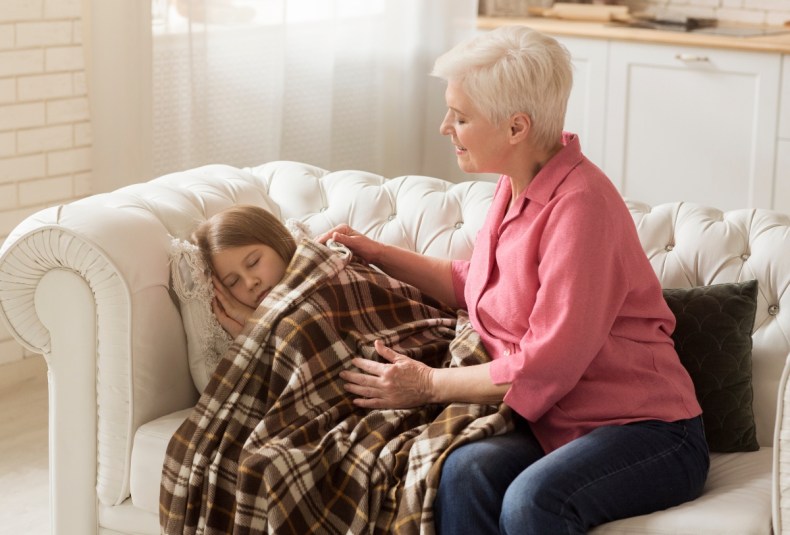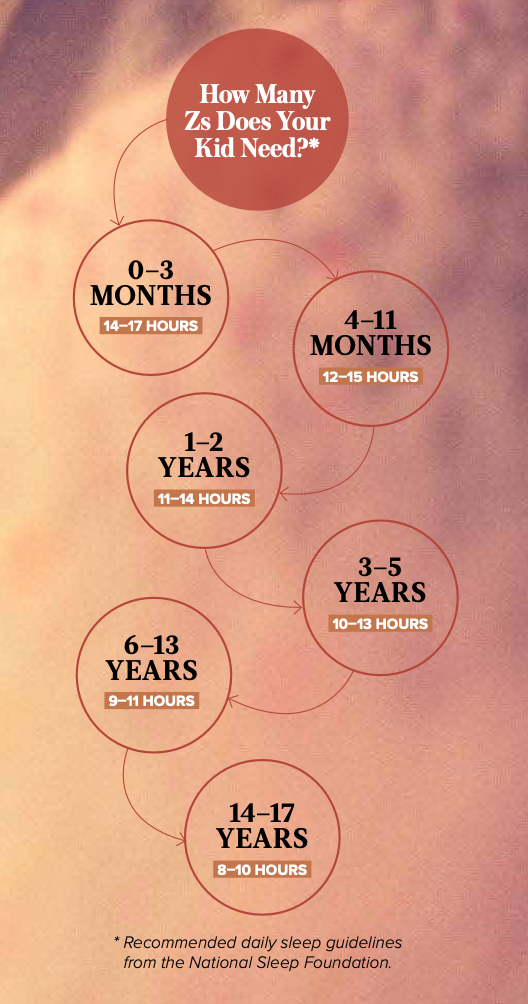How To Create Good Sleep Habits for Kids — 11 Sleep Tips for Infants, Adolescents, and Teens
High quality shut-eye is vital for children.

Let’s talk about good sleep habits for kids. Like most parents, our path to establishing them wasn’t a straight line. To this day, I vividly recall the day my daughter decided to stop sleeping through the night. She was six months old and we were on a trip to Bend, Oregon. Until then, my husband and I thought of her as a “good sleeper.” Typically, she woke up once — maybe twice — a night, but she usually went back down easily. As new parents, we were getting more sleep than we expected — and certainly more than we’d been told we would get by our friends with kids.
On that trip to Oregon, though, things changed — and fast. She started crying at around midnight, and we shushed her back down. This happened again at 2 a.m; then at 4 a.m.; once more at 6 a.m.; and… well, you get the picture. It was like we accidentally set an alarm clock to go off every two hours. This continued throughout the trip. On the drive home, I thought it might be because we were traveling, and I assumed she’d resume her peaceful sleep schedule once she was back in her crib.
Boy was I was wrong. Sleep became a nightly battle for the next four-plus months. I now know that despite the fact that she was sleeping fairly well in the beginning, my husband and I should have equipped our daughter with some tools that might have made things easier later on.
“Sleep health is like building blocks,” says Jodi Mindell, Ph.D., a professor at Saint Joseph’s University in Philadelphia and associate director of the Sleep Center at Children’s Hospital of Philadelphia. “Parents can start putting them in place one piece at a time, beginning when their children are newborns.”
She points out that sleep affects all aspects of our wellbeing, and that if we don’t get enough, it impacts our mood, behavior, cognition, and overall health. This is true, she notes, of both infants and adults.
If you’ve just had a baby, or if you feel like your sleep training has fallen off course, there are numerous ways to establish good sleep habits for kids. Below are top sleep tips for infants, adolescents, and teens.
Good Sleep Habits for Infants & Toddlers
Create a routine. It doesn’t really matter what your routine is, so long as you’re being consistent from night to night. According to Mindell, this is vital for establishing good sleep habits for kids, especially when your baby is a few months old. For a newborn, the routine may simply include a bath, a diaper change, milk, and a lullaby before bed. For a toddler, it could be bath, pajamas, brushing teeth, and a book.
Set the clock. “Establish regular sleep/wake patterns as early as possible (once there is some regular pattern that emerges), so that you can teach your child the importance of routines and bedtime — and set appropriate expectations for sufficient sleep and rest,” says Sally Ibrahim, M.D., a sleep medicine specialist at University Hospitals Cleveland Medical Center. If your toddler starts to push back on those times, resist the urge to let them stay up later.
Give them a bath (but not too early). Taking a warm bath will raise your child’s core body temperature. When she gets out, her body temp naturally drops, which enhances the drowsiness response, explains Jerald Simmons M.D., a neurologist and sleep medicine specialist in Houston. However, this benefit lasts only 45 minutes to an hour. Aim to put them to bed during that window, he adds.
Encourage self soothing. “If an infant gets used to being held or fed to fall asleep, then they’ll expect it to happen every time they wake up at night and will cry until that condition is reintroduced,” says Ibrahim. Babies make associations quickly, so create a sleep routine that doesn’t rely on a family member and allows your child to self-soothe instead. If their ability to sleep relies solely on the presence of mom or grandma, for example, this makes things difficult. Try to put your child to bed while drowsy, but awake. If this leads to a “cry it out” situation, remind yourself that while it’s incredibly hard, it won’t last forever.
Don’t disregard naps. Trouble with daytime naps can mean trouble at night as well. Therefore, it’s important to be consistent and follow an abbreviated bedtime routine for these. According to the National Sleep Foundation, when it’s time for your toddler to drop one (or all!) naps, you should ease into the change gradually. Consider turning what would be nap time into a new quiet time. This can be a period when your child or grandchild can read books, color, or listen to calming music.
Good Sleep Habits for Pre-adolescents
Get outside. “Melatonin helps your brain go to sleep, and your levels of it change when your body is exposed to different types of light,” explains Simmons. “They’re lower when it’s bright and higher when it’s dark.” But, it’s the fluctuation in levels between day and night that provide great sleep-inducing benefits and help to establish good sleep habits for kids, he adds. So, if you’re inside all day, you’ll miss out, making it more difficult to fall asleep. Playtime in the backyard or an hour at the park after school before heading home could make a difference.
Shut down electronics for a good night’s sleep. “Research shows that implementing a consistent bedtime is associated with adequate sleep, even in adolescents,” says Ibrahim. It’s important to impose limitations on things that may get in the way of their shut-eye, such as phones or computers, and to dim the lights in their room at night. One recent study found that kids who used digital devices before bed were more likely to get less sleep and have a higher BMI than their tech-free peers.
Don’t ignore daytime behavior. Sleep issues can pop up at any time, and they’re not always obvious to spot. Ask yourself, “How’s my child’s daytime performance?” If they seem tired all the time and you’re noticing he or she is struggling at school or elsewhere, then you might want to talk to a sleep specialist, notes Simmons. Also, snoring is abnormal at any age. “If your child isn’t sleeping through the night or is breathing heavily while he sleeps, talk to your pediatrician about the possibility of sleep apnea,” says Ibrahim.

Good Sleep Habits for Teens
Wake them up. “Some parents allow their kids to sleep in as long as possible on the weekends, but it’s important to maintain a regular schedule,” says Ibrahim. “Your best bet is to keep sleep/wake times within an hour or two of normal. Otherwise, kids can end up with social ‘jet lag’ on Sunday night, which makes it hard to go to sleep and creates a snowball effect of late nights and tired days for the rest of the week.” As tempting as it may be to let them have their rest after a long week of school and activities, establishing good sleep habits for kids — especially teens — requires that they stay somewhat within their typical sleep schedule.
Keep messaging to a minimum. Try to get your teens to shut down for the night before they enter their bedrooms. “If they’re texting or staying digitally engaged with their friends, then they’ll never drift off. Turn off their phones, tablets, etc.,” says Simmons. Better yet, keep the electronic devices out of the bedroom altogether and charge them in another room. A digital alarm clock on their bedside table does the same thing that a cellphone alarm does!
Make sleep a routine. Less sleep time for teens has been associated with car accidents, mood disturbances and other high-risk behaviors, such as smoking, notes Ibrahim. Yet with all the social — and scholastic — pressures that come with being in high school, lots of teenagers are at least a little sleep-deprived. “The biological sleep patterns for adolescents and teens shift toward later sleep/wake times, so it’s natural for them to not be able to fall asleep earlier,” explains Simmons. “However, we all function better with a routine, when our body knows what to expect.”
A version of this article appeared in our partner magazine The Science of Raising Happy Kids.












